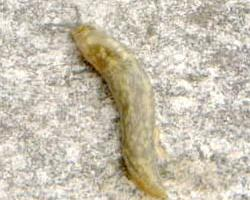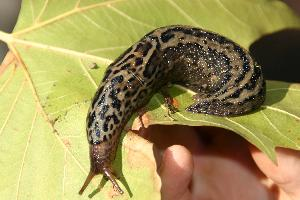
Statut de conservation
| Intrépide |
Description de l'animal
The Cellar Slug, scientifically known as Limacus flavus, is a terrestrial gastropod mollusk that belongs to the family Limacidae. This species is notable for its distinctive physical characteristics and behaviors, making it a subject of interest both ecologically and scientifically.Physical Description:
Limacus flavus typically exhibits a pale yellow or greenish-yellow body, adorned with darker mottled patterns that can vary significantly between individuals. The body of the slug is elongated and can stretch considerably when the animal is in motion, usually reaching lengths of up to 10-15 centimeters (about 4-6 inches) when fully extended. The skin of the Cellar Slug is smooth and moist, a feature that aids in its locomotion and respiration. It possesses a mantle, a specialized tissue covering part of its dorsal side, which houses the respiratory pore or pneumostome, crucial for breathing. Another distinctive feature is its tentacles; like many slugs and snails, Limacus flavus has two pairs of tentacles on its head. The upper, longer pair is equipped with eye spots at the tips, while the lower pair is used for tactile and olfactory purposes.
Habitat and Distribution:
Originally hailing from the Mediterranean region, the Cellar Slug has successfully expanded its range to many parts of the world, including much of Europe and North America, primarily due to human activities. It thrives in damp, cool environments and is commonly found in urban and suburban areas, taking refuge in cellars, gardens, and greenhouses, which provide the moist conditions it prefers. The adaptability of Limacus flavus to different habitats is a key factor in its widespread distribution.
Diet and Behavior:
Limacus flavus is nocturnal, emerging from its hiding places at night to feed. Its diet is quite varied and includes a wide range of plant materials, such as leaves, flowers, and fruits, making it a generalist feeder. However, it can also consume decaying organic matter and even other slugs, showcasing opportunistic feeding behavior. The Cellar Slug is known for its ability to climb vertical surfaces, even glass, in search of food, a feat made possible by the secretion of a special mucus from its foot.
Reproduction:
The reproduction of Limacus flavus is hermaphroditic, meaning each individual possesses both male and female reproductive organs. Mating typically involves a complex courtship ritual, culminating in the exchange of sperm between two individuals. Subsequently, each slug lays clusters of translucent eggs in moist, hidden locations. These eggs hatch into tiny, fully formed slugs, which then begin the process of growth and development.
Ecological Role and Human Interaction:
The Cellar Slug plays a significant role in the ecosystem as both a consumer of plant material and decaying matter and as prey for a variety of predators, including birds, mammals, and insects. While generally not harmful, it can become a pest in agricultural and horticultural settings, where it may damage seedlings and plants. In residential areas, its presence is often noted due to its tendency to enter homes in search of food or shelter, leading to its common name.
In conclusion, Limacus flavus, the Cellar Slug, is a fascinating creature with a broad ecological niche and a capacity for adaptation that has allowed it to colonize diverse environments across the globe. Its study contributes to our understanding of gastropod biology, ecology, and the impacts of invasive species.
Animaux similaires
Nouvelles photos d'animaux
Top 10 des animaux
- Dolphin gull (Leucophaeus scoresbii)
- Diana monkey (Cercopithecus diana)
- Moustached guenon (Cercopithecus cephus)
- Galápagos tortoise (Geochelone nigra complex)
- Russian tortoise (Testudo horsfieldii)
- Stone loach (Barbatula barbatula)
- Japanese macaque (Macaca fuscata)
- Greek tortoise (Testudo graeca)
- Common flying dragon (Draco volans)
- Vendace (Coregonus albula)

